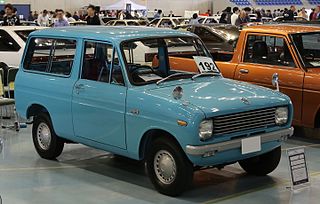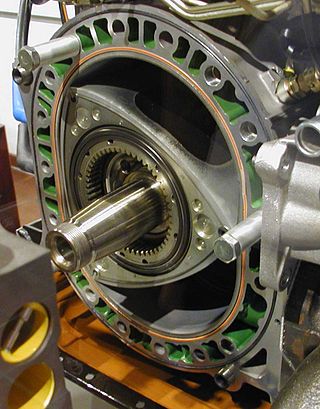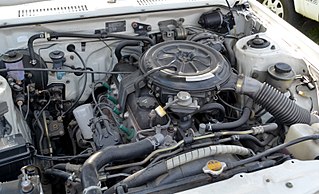
The Mazda Porter and Porter Cab are a series of small kei trucks that were produced from 1961 to 1989 by Mazda, mainly for sale in the domestic Japanese market. Export versions of the Porter were labelled E360. The Porter was replaced by the Autozam Scrum, a rebadged Suzuki Carry.
The Mazda B-series engine - not to be confused with the Mazda B-Series truck - is a small-sized, iron-block, inline four-cylinder with belt-driven SOHC and DOHC valvetrain ranging in displacement from 1.1 to 1.8 litres. It was used from front-wheel drive economy applications to the turbocharged full-time 4WD 323 GTX and rear-wheel drive Miata as well as numerous other models. The Mazda B-series is a "non-interference" design, meaning that breakage of its timing belt does not result in damage to valves or pistons, because the opening of the valves, the depth of the combustion chamber and the shaping of the piston crown allow sufficient clearance for the open valves in any possible piston position.
The C family was Mazda's first large piston engine design. It is not certain whether Mazda has a name for this collection of engines, and it is uncertain precisely which ones are related.

The Mazda Wankel engines are a family of Wankel rotary combustion car engines produced by Mazda.

Mazda has a long history of building its own diesel engines, with the exception of a few units that were built under license.

The VK engine is a V8 piston engine from Nissan. It is an aluminum DOHC 4-valve design.

The E-series was a line of inline four-cylinder automobile engines designed and built by Honda for use in their cars in the 1970s and 1980s. These engines were notable for the use of CVCC technology, introduced in the ED1 engine in the 1975 Civic, which met 1970s emissions standards without using a catalytic converter.

The Toyota K series is an inline-four engine that was produced from 1966 through 2007. It is a two-valve pushrod engine design. It was originally built from the Toyota Kamigo plant in Toyota City factory in Japan.

The Prince G-series engine was the company's only straight-four and straight-six engines which began production in 1955. A number of variations were made, with both OHV and OHC heads. A diesel four-cylinder with 1.9 L (1,862 cc) was also built, called the D-6. The G series was used in the Skyline, the Laurel, and the Gloria from the 1950s to the early 1970s.

The Honda R engine is an inline-four engine launched in 2006 for the Honda Civic (non-Si). It is fuel injected, has an aluminum-alloy cylinder block and cylinder head, is a SOHC 16-valve design and utilizes Honda's i-VTEC system. The R series engine has a compression ratio of 10.5:1, features a "drive by wire" throttle system which is computer controlled to reduce pumping losses and create a smooth torque curve.
The Mitsubishi Neptune or 4G4 engine is a series of iron-block OHV inline-four engines built by Mitsubishi Motors from June 1971 to 1981. This was to be Mitsubishi's last OHV engine. The inability to clear new passenger car emissions rules for 1978 meant that the Neptunes were replaced by the 4G1 Orion. The Neptune continued to be built until 1979 for commercial vehicles, which suffered less restrictive environmental regulations and until about 1981 for other applications. Around 520,000 Neptune engines were built.
The Toyota B engine family was a series of inline-four diesel engines.

The Toyota Y engine is a series of overhead valve straight-four petrol engines manufactured by Toyota from 1982 through 1996. The Y engine has mostly been used in commercial and off-road vehicles.

The Suzuki F engine is a series of inline three- and four-cylinder internal combustion petrol engines manufactured by Suzuki Motor Corporation and also licensed by many manufacturers for their automobiles. This engine was Suzuki's first four-stroke car engine when it first appeared in 1977.

The Suzuki K engine family is a series of all aluminium inline-three or four cylinder automobile engines from Suzuki, introduced in 1994. The displacement is ranging from 0.7 L to 1.5 L. This is a timing chain head driven DOHC 4-valve per cylinder engine with using multipoint fuel injection or direct injection fuel system, turbocharged for some variants and also available with hybrid electric technology.










